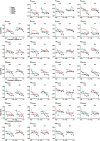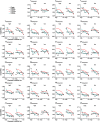Dopaminergic Modulation of Human Intertemporal Choice: A Diffusion Model Analysis Using the D2-Receptor Antagonist Haloperidol
- PMID: 32948675
- PMCID: PMC7548690
- DOI: 10.1523/JNEUROSCI.0592-20.2020
Dopaminergic Modulation of Human Intertemporal Choice: A Diffusion Model Analysis Using the D2-Receptor Antagonist Haloperidol
Abstract
The neurotransmitter dopamine is implicated in diverse functions, including reward processing, reinforcement learning, and cognitive control. The tendency to discount future rewards over time has long been discussed in the context of potential dopaminergic modulation. Here we examined the effect of a single dose of the D2 receptor antagonist haloperidol (2 mg) on temporal discounting in healthy female and male human participants. Our approach extends previous pharmacological studies in two ways. First, we applied combined temporal discounting drift diffusion models to examine choice dynamics. Second, we examined dopaminergic modulation of reward magnitude effects on temporal discounting. Hierarchical Bayesian parameter estimation revealed that the data were best accounted for by a temporal discounting drift diffusion model with nonlinear trialwise drift rate scaling. This model showed good parameter recovery, and posterior predictive checks revealed that it accurately reproduced the relationship between decision conflict and response times in individual participants. We observed reduced temporal discounting and substantially faster nondecision times under haloperidol compared with placebo. Discounting was steeper for low versus high reward magnitudes, but this effect was largely unaffected by haloperidol. Results were corroborated by model-free analyses and modeling via more standard approaches. We previously reported elevated caudate activation under haloperidol in this sample of participants, supporting the idea that haloperidol elevated dopamine neurotransmission (e.g., by blocking inhibitory feedback via presynaptic D2 auto-receptors). The present results reveal that this is associated with an augmentation of both lower-level (nondecision time) and higher-level (temporal discounting) components of the decision process.SIGNIFICANCE STATEMENT Dopamine is implicated in reward processing, reinforcement learning, and cognitive control. Here we examined the effects of a single dose of the D2 receptor antagonist haloperidol on temporal discounting and choice dynamics during the decision process. We extend previous studies by applying computational modeling using the drift diffusion model, which revealed that haloperidol reduced the nondecision time and reduced impulsive choice compared with placebo. These findings are compatible with a haloperidol-induced increase in striatal dopamine (e.g., because of a presynaptic mechanism). Our data provide novel insights into the contributions of dopamine to value-based decision-making and highlight how comprehensive model-based analyses using sequential sampling models can inform the effects of pharmacological modulation on choice processes.
Keywords: computational modeling; decision making; dopamine; haloperidol; intertemporal choice; pharmacology.
Copyright © 2020 the authors.
Figures










Similar articles
-
The drift diffusion model as the choice rule in inter-temporal and risky choice: A case study in medial orbitofrontal cortex lesion patients and controls.PLoS Comput Biol. 2020 Apr 20;16(4):e1007615. doi: 10.1371/journal.pcbi.1007615. eCollection 2020 Apr. PLoS Comput Biol. 2020. PMID: 32310962 Free PMC article.
-
An improved within-session self-adjusting delay discounting procedure for the study of choice impulsivity in rats.Psychopharmacology (Berl). 2018 Jul;235(7):2123-2135. doi: 10.1007/s00213-018-4911-y. Epub 2018 Apr 30. Psychopharmacology (Berl). 2018. PMID: 29713789
-
Effects of a cafeteria diet on delay discounting in adolescent and adult rats: Alterations on dopaminergic sensitivity.J Psychopharmacol. 2017 Nov;31(11):1419-1429. doi: 10.1177/0269881117735750. Epub 2017 Oct 25. J Psychopharmacol. 2017. PMID: 29067887
-
Dopaminergic modulation of reward discounting in healthy rats: a systematic review and meta-analysis.Psychopharmacology (Berl). 2021 Mar;238(3):711-723. doi: 10.1007/s00213-020-05723-5. Epub 2020 Nov 19. Psychopharmacology (Berl). 2021. PMID: 33215269
-
Pharmacological Modulation of Temporal Discounting: A Systematic Review.Healthcare (Basel). 2023 Apr 6;11(7):1046. doi: 10.3390/healthcare11071046. Healthcare (Basel). 2023. PMID: 37046974 Free PMC article. Review.
Cited by
-
Dopamine Alters the Effect of Brain Stimulation on Decision-Making.J Neurosci. 2023 Oct 11;43(41):6909-6919. doi: 10.1523/JNEUROSCI.1140-23.2023. Epub 2023 Aug 30. J Neurosci. 2023. PMID: 37648451 Free PMC article.
-
Dopamine regulates decision thresholds in human reinforcement learning in males.Nat Commun. 2023 Sep 4;14(1):5369. doi: 10.1038/s41467-023-41130-y. Nat Commun. 2023. PMID: 37666865 Free PMC article.
-
Decomposition of Reinforcement Learning Deficits in Disordered Gambling via Drift Diffusion Modeling and Functional Magnetic Resonance Imaging.Comput Psychiatr. 2024 Mar 20;8(1):23-45. doi: 10.5334/cpsy.104. eCollection 2024. Comput Psychiatr. 2024. PMID: 38774428 Free PMC article.
-
Dopamine and acetylcholine have distinct roles in delay- and effort-based decision-making in humans.PLoS Biol. 2024 Jul 12;22(7):e3002714. doi: 10.1371/journal.pbio.3002714. eCollection 2024 Jul. PLoS Biol. 2024. PMID: 38995982 Free PMC article.
-
Erotic cue exposure increases neural reward responses without modulating temporal discounting.Imaging Neurosci (Camb). 2023 Aug 18;1:imag-1-00008. doi: 10.1162/imag_a_00008. eCollection 2023. Imaging Neurosci (Camb). 2023. PMID: 40799696 Free PMC article.
References
Publication types
MeSH terms
Substances
LinkOut - more resources
Full Text Sources
